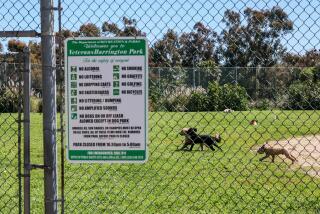L.A.’s animal shelter test
As money woes strain the city’s resources, Los Angeles officials have been engaged in a continuing and important discussion: What are the responsibilities the city handles best itself? And what are those the city can, and should, contract out? Some are obvious: The city should run its own police department, for instance. Some are not so obvious.
The latest to fall under scrutiny is the operation of animal shelters. There are six scattered across the city that are open to the public and that take in and adopt out thousands of unwanted and stray animals. It is the seventh shelter — in the Northeast Valley area of Mission Hills — that has been the city’s problem child. Built to be a fully operational shelter, it has never been available to the public. In the three years since it opened, it has housed nursing animals and dogs held for legal reasons, such as those involved in court cases.
Earlier this year, the city sent out a “Request for Information” seeking a nonprofit contractor to operate the facility. The respected national organization Best Friends Animal Society was the only group to respond, according to city officials. The city’s administrative officer, as well as officials of the L.A. Department of Animal Services, have recommended the group be chosen.
In the context of the city’s quest to discern between its core competencies and its more dispensable operations, this proposal is a tricky one. Animal Services is a core city service and one that Los Angeles provides reasonably well; that argues for keeping the operations within city government. But resources are such that this shelter will not open to the public unless a private operator takes it over.
The idea has its critics — they say Best Friends was selected with little transparency or community input. Supporters of the idea, including L.A. Animal Services General Manager Brenda Barnette, argue that the deal represents the best and most cost-efficient chance to get the Mission Hills shelter open to the public for the first time. Barnette and other officials estimate that if the city ran the shelter instead, it would cost as much as $3.3 million a year.
That’s enough reason to give this a try. The City Council is expected to vote Tuesday, and the proposed arrangement with Best Friends offers an opportunity for the city to experiment with a new model of a public-private partnership to provide a service that the city performs well but that, in these difficult times, it may need to give over to others. If the council approves the deal, which it is expected to do, it should commit the city to evaluating the success of this approach and determining its future applicability. If the arrangement works to the city’s satisfaction, it may point to future opportunities for such partnerships; if not, the city should be prepared to drop it.
More to Read
A cure for the common opinion
Get thought-provoking perspectives with our weekly newsletter.
You may occasionally receive promotional content from the Los Angeles Times.










